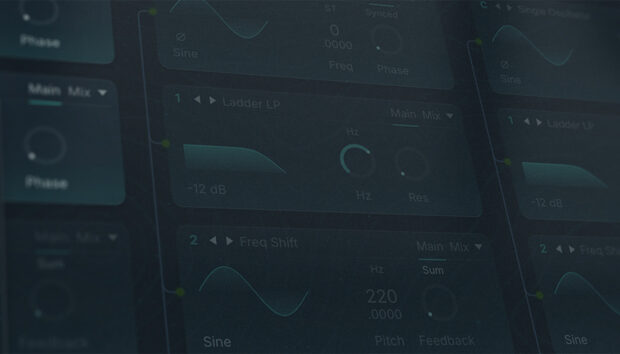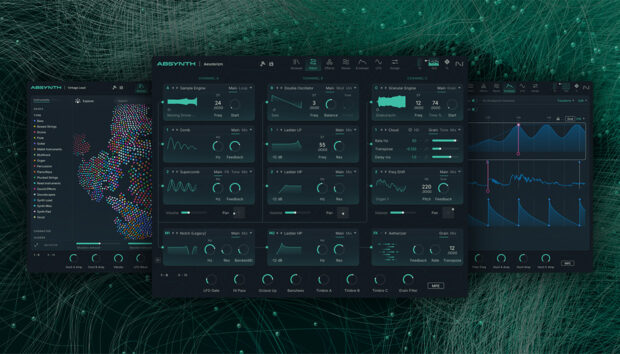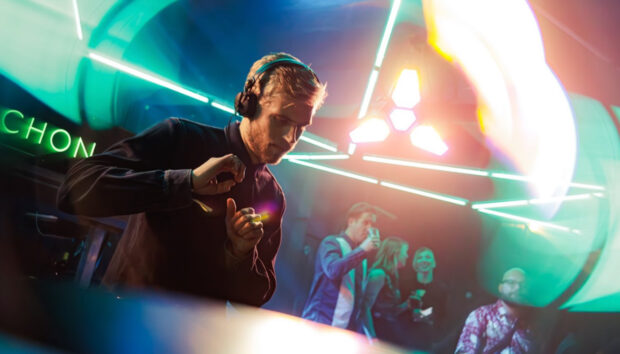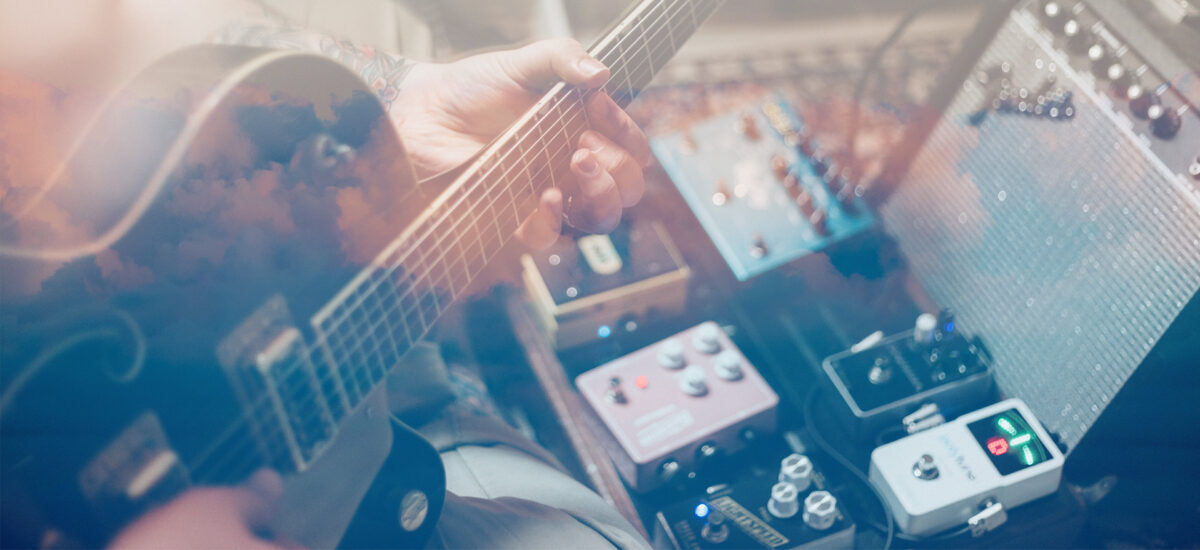
With all things ‘90s swinging back into vogue, let’s dive into one of the staple sounds of the era—shoegaze. Known for loudness and sweeping, fuzzy textures, shoegaze has more of an indie-rock vibe than the punk and metal influences heard in grunge (a similar genre from the same period.)
With innovative use of effects to produce new tones and textures from traditional instruments, shoegaze has had a subtle but very real impact on wider popular music.
This guide runs through the past, present, and future of shoegaze. With the power of modern production and the accessibility of quality software effects and instruments, the sky is the limit.
Jump to these sections:
Get the shoegaze sound with Guitar Rig 7 Pro, a powerful multi-effects rack and amp simulator made for creating in a way that is fast and direct.
What is shoegaze music?
Shoegaze is a style of alternative rock music characterized by dense, shimmering textures of distorted guitars, thundering drums, and dreamy, reverb-heavy vocals.
The shoegaze genre originated in the UK, gaining popularity in the late ‘80s and early ‘90s. The name ‘shoegaze’ had negative connotations at first, coined by a disparaging journalist—much like ‘grunge’, which was emerging around the same time on the other side of the Atlantic.
‘Shoegazing’ referred to the way performers stood still on stage, looking down at the floor as they played, lacking the charisma and machismo of big stadium rock acts.
The music was not mainstream by design, and this sense of introversion and understatement became an ideology behind the shoegaze genre. Slowdive’s Simon Scott called it “anti showmanship.”
But the meaning of ‘shoegaze’ is twofold. Guitar pedal effects are a major component of the shoegaze sound—in particular delay and distortion. The artists were not gazing at their shoes, they were working the pedalboard in real time.
The foundation of the shoegaze sound is a wall of powerful guitar noise, created by combining fuzz or distortion pedals with long, drawn-out delay and reverb. The shimmering dynamics are created with chorus, tremolo, flanger, or phaser effects.
Many pedals used in the shoegaze heyday are still on the market and relatively affordable. Alternatively, Guitar Rig 7 Pro gives you access to a huge selection of amplifiers and effects to experiment with and layer up in handy software form.
A short history of shoegaze music
The shoegaze genre has its roots in ‘60s psychedelic rock, as well as the American indie sounds of Dinosaur Jr. (who toured the UK in the early ‘90s) and Sonic Youth. Other early influences include The Velvet Underground, the Cure, and Siouxsie and the Banshies. Two Scottish bands—Cocteau Twins and the Jesus and Mary Chain—are credited as being progenitors of the shoegaze style.
Shoegaze began to evolve into a distinctive sound of its own, with an emphasis on cranked-up effects and overwhelming loudness. The genre’s early ‘90s peak was led by titans of this heavier shoegaze sound, including My Bloody Valentine, Ride, Lush, the Pale Saints, Swervedriver, and Catherine Wheel.
The signature shoegaze sound is built around guitars, bass, and drums, but you can recreate a classic rock band line-up using virtual instruments.
The shoegaze scene was known for its positive, supportive community, with a greater presence of female band members and vocalists than other music scenes at the time. Despite its appeal, shoegaze was sidelined before long by similar genres that exploded in the mid-90s—Britpop in the UK and the huge commercial success of US grunge. Grunge and Britpop were perhaps more accessible and relatable, while shoegaze was derided for being self-indulgent, complicated, and geeky. Though there are some big-name shoegaze bands and records, it was and is something of a cult scene and a niche sound. Nevertheless, the influence of shoegaze endures to this day.
Iconic songs by shoegaze artists
My Bloody Valentine – “Only Shallow”
My Bloody Valentine’s Loveless (1991) is generally agreed to be the quintessential shoegaze record, a landmark masterpiece that perfectly encapsulates the shoegaze genre.
Right from album opener “Only Shallow,” we are pummeled with a wave of overwhelming, euphoric noise. The song shows off the signature shoegaze marriage of the heavy and visceral with the dreamy and sentimental. Pretty songs are hidden in swamps of noisy textures, making for a challenging but rewarding listening experience.
Notice how the chords seem to warp and pitch bend—this technique was innovated by MBV guitarist Kevin Shields, using a whammy bar while he strums to produce a loose, almost drunk effect that is much imitated.
“Ride” – Vapour Trail
Ride produced a shoegaze classic with their 1990 debut Nowhere. The album has achieved legendary status, garnering attention far beyond the shoegaze scene.
The band finds a perfect balance of droning riffs and heavy drums combined with catchy, melodic pop hooks. “Vapour Trail” shows off the band’s softer side, while sustaining a powerful, swelling energy as repeating chord patterns are looped into long, hypnotic sections.
After Ride split up in 1996, vocalist and guitarist Andy Bell joined Oasis—evidence of the cultural direction of travel away from shoegaze and towards Britpop.
“The Verve” – Blue
The Verve are not primarily thought of as a shoegaze act, but their early output bears all the hallmarks of the genre.
Released in 1993, debut album A Storm in Heaven precedes the band’s later global success (peaking with the 1997 hit “Bittersweet Symphony.”)
More reflective of the alternative scene at the time, this album features a heady mix of tape echo and reverb, with a focus on guitar textures over virtuoso shredding.
“Blue” has a neat song structure, ideal for a radio single. Elsewhere on the album the band relaxes into looser jams, reflecting the improvisation and spontaneity they brought into the recording sessions.
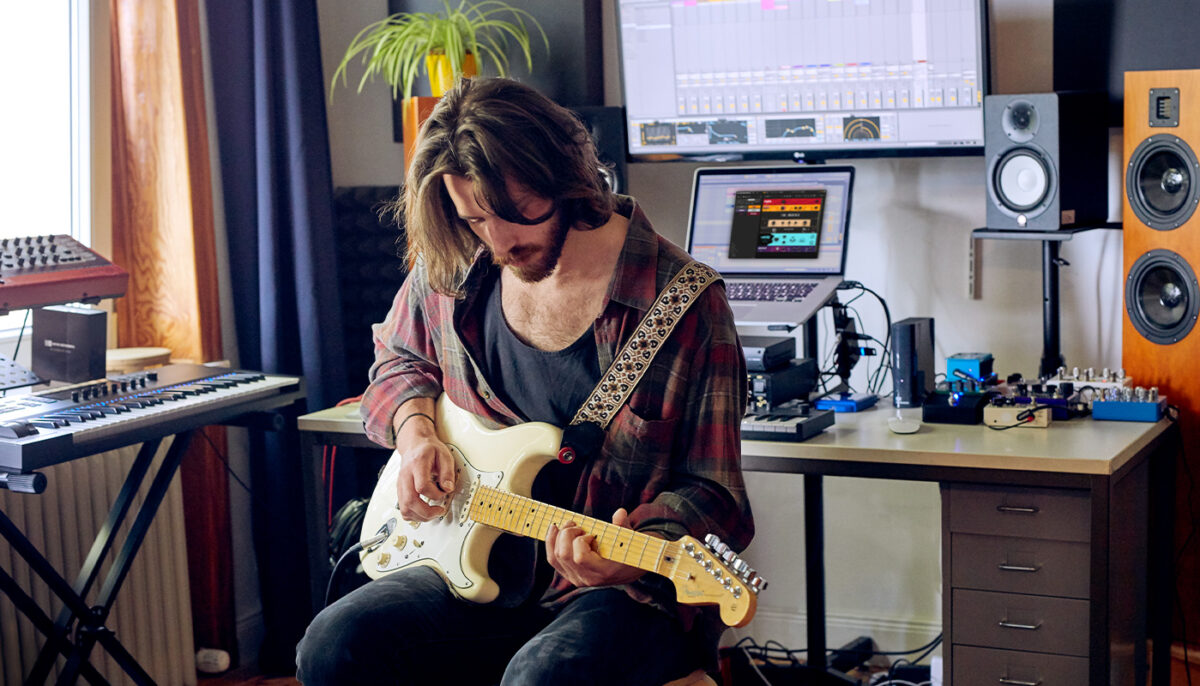
4 tips for making shoegaze music
Now that we’ve explored the background of the shoegaze genre and heard some key examples, let’s look at how to make shoegaze music with 4 ways to apply some of its influence in your music productions.
1. Blend your instruments together with effects
The key to the shoegaze sound is how the guitars, drums, and vocals are blended together into one thick soundscape.
In shoegaze, the effects are the music—often the notes played or sung are quite simple, yet the output after processing is vast and maximal.
Experiment with reverb and delay effects to create a sense of space. Pushing up the feedback or wet signal adds a heavy, sustaining tail, with notes and chords stacking into an expansive wall of sound.
It’s easy for the mix to get muddy, so delicate EQing and the correct balancing of elements is important. bx_delay 2500 from Brainworx is a versatile software delay unit, with chorus, distortion, and compression built in to help you find the ideal blend.
2. Use distortion to create fuzz, dirt, and noise
Shoegaze performances are known for being LOUD. Distortion plays a big role in the sound—crashing waves of fuzz, dirt, and noise. In the case of My Bloody Valentine, the guitar tone sounds like it’s almost corrupting and cracking from the intensity.
While hardware guitar pedals were the order of the day in the ‘90s shoegaze golden age, we now have the addition of powerful software plug-ins. Some of these, like iZotope’s Trash 2, have become iconic in their own right. Trash 2 is being discontinued, but it lives on in ‘Trash mode” as part of Neutron 4, integrating distortion into the mixing process.
An effective shoegaze trick is to place distortion at the end of the signal chain, to crunch together the long reverb tails and other effects.
3. Consider incorporating elements of modern shoegaze
Although shoegaze’s peak was short-lived, it generated a web of splinter genres, with new artists reinventing and keeping the music alive. The signature shoegaze sound broadened out over time, merging with other genres including heavy metal, ambient, and electronica.
The melodic sounds of dream pop are a clear influence on today’s lo-fi and chillwave genres. At the opposite end of the spectrum, “blackgaze” fuses floaty shoegaze drones with the darker tones of black metal.
Check out this interview with Deafheaven’s Kerry McCoy, where he touches on the enduring impact of shoegaze and introduces his collection of custom Guitar Rig presets.
4. Use effects to bring a shoegaze quality to other instruments
If we’re thinking about the future of shoegaze, then carrying its warped guitar sounds and effects chains into the realm of electronic production feels like a logical next step.
Try applying the tone and feel of shoegaze to different instruments and sound palettes—for example, processing synth pads with heavy delay and distortion to create an intense wash of noise, or using the pitch-bend feature on digital instruments to recreate the gliding, wavering lead lines of shoegaze.
Producer Orchin spoke with Native Instruments on Instagram about creating ‘fake’ guitar sounds using virtual instruments, using traditional guitar-dominated sounds as a foundation, and putting a modern twist on ‘90s nostalgia.
Start making shoegaze music
Now that you have a solid understanding of the style, history, and dreamy production elements of shoegaze, it’s time to start making your own shoegaze tracks. Explore Guitar Rig 7 Pro for a great starting point, and learn more about music production in our ultimate guide.











